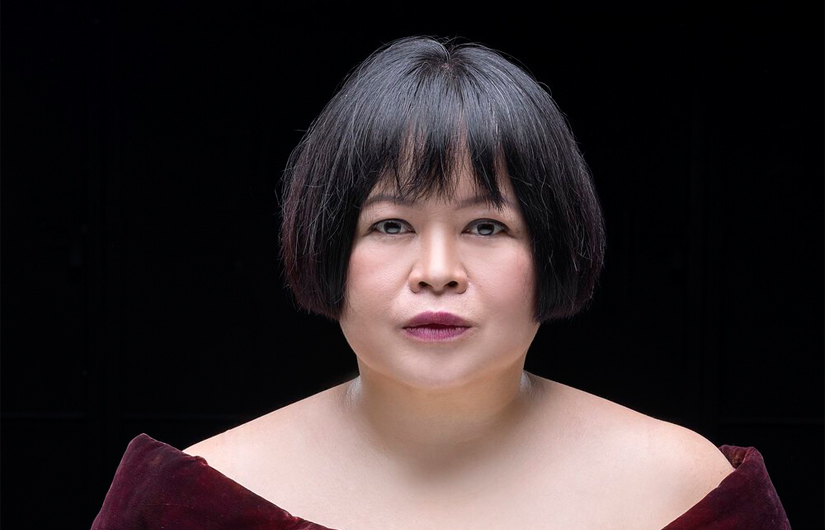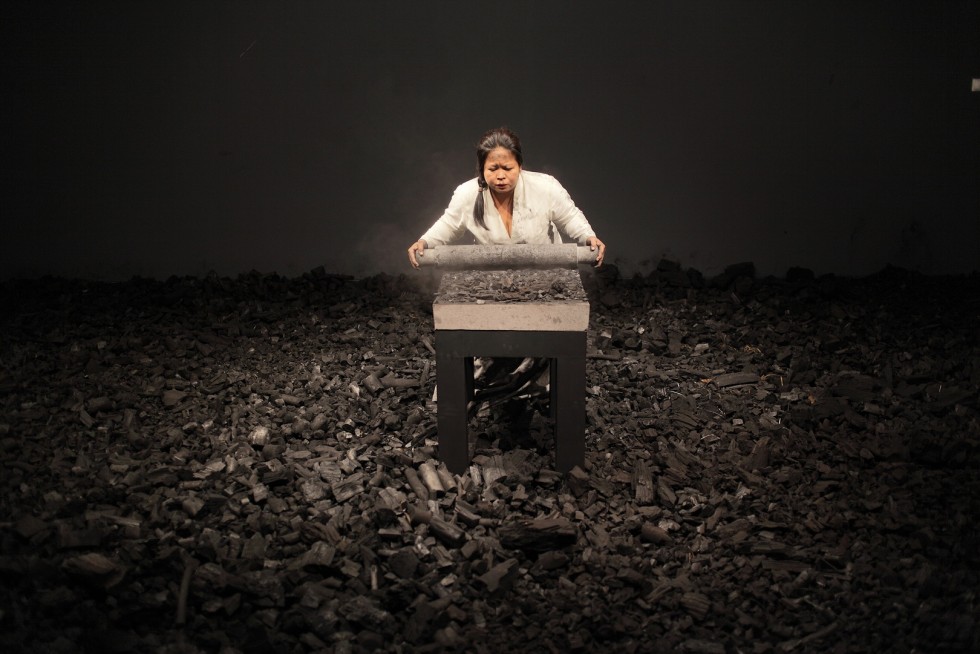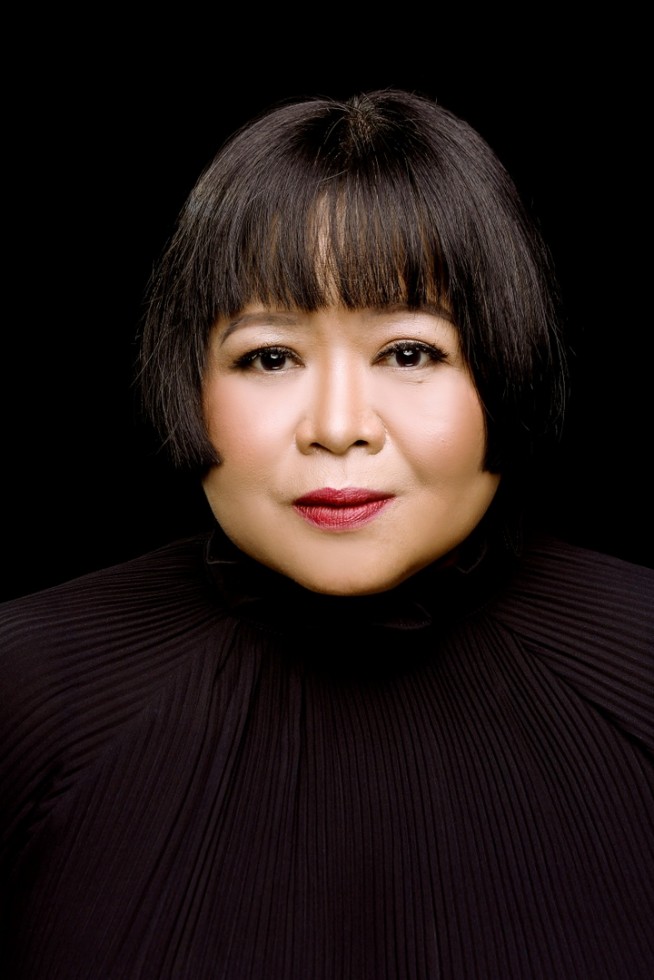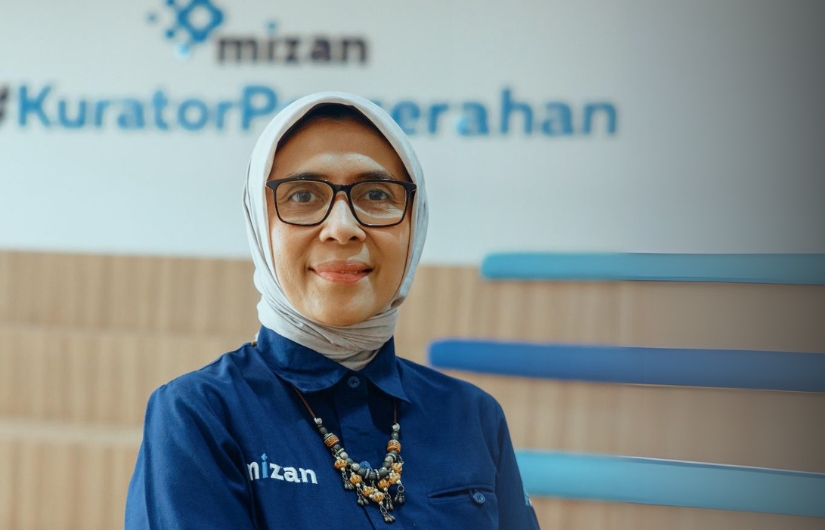Photo courtesy of Melati Suryodarmo
Story by Sartika Dian
All rights reserved
Melati Suryodarmo's name reverberates through the art world like a powerful echo, and in 2022, she achieved the prestigious Bonnefanten Award for Contemporary Art, her groundbreaking work as a performance artist. Born in the vibrant city of Surakarta, Indonesia, Melati's artistic journey finds its roots in her early childhood experiences, a compelling narrative that intertwines the profound essence of dance and the enigmatic allure of performance art. In this exclusive interview with Elite+, we embark on a journey through her formative years, unraveling the intricate threads that compose the tapestry of her artistry, beliefs, and aesthetic philosophy.
Melati was born into a family deeply immersed in the world of dance and performance. Her father, a dancer himself, would take her to Sasono Mulyo, located near the palace of Surakarta Hadiningrat. This exposure to the world of traditional Javanese dance became a foundational experience that would eventually influence her artistic endeavors.
Notably, both of her parents were accomplished dancers, instilling a passion for movement and expression within her from a young age. Melati was sent to learn the intricate art of Javanese dance in Kemlayan, a significant center in the old town of Surakarta. It was there that she had her first encounter with her early tutor, the renowned S. Ngariman Condropengrawit, a master of Javanese dance.
Growing up surrounded by this artistic environment, Melati Suryodarmo began to observe her father's unique approach to movement. He pioneered a form of body movement that can be described as Experimentalism, which he later termed the "Amerta movement." This groundbreaking style combined elements of Javanese martial arts, meditation, and Javanese philosophy.
During her formative years, Melati's father's unconventional approach to dance challenged traditional norms. His fusion of martial arts, meditation, and philosophy was a departure from the familiar Javanese dance forms, introducing a new dimension to the concept of contemporary dance at the time. This innovation, although met with skepticism initially, planted the seeds of curiosity and exploration in Melati's mind.
Early Years
Integral to Melati Suryodarmo's artistic journey is the practice of Sumarah meditation, a profound aspect of Javanese culture. This meditation begins with a dialogue with one's inner organs and inner being, emphasizing a deep connection with the self. Sumarah meditation became a cornerstone of her personal and artistic development, fostering introspection and self-awareness that would shape her future performances.
As Melati pursued her education in International Politics at Padjajaran University in Bandung, her journey into the world of performance art took an unexpected turn. She crossed paths with a group of experimental artists and friends, including Marintan Sirait, Andar Manik, etc, who were musicians, theater actors, and actresses. These encounters led to weekly practices in a basketball arena in Kanayakan Bandung under the banners of "Parengkel Jahe" and "Sumberwaras."
Furthermore, her involvement in the Gelanggang Seni, Sastra, Teater, dan FIlm (GSSTF) introduced her to many more influential figures in the world of arts. This diverse and dynamic environment not only fueled her artistic aspirations but also connected her with student activism during a time of political unrest in Indonesia.
During her time in Bandung from 1988 to 1993, Melati was exposed to the vibrant intellectual and artistic dynamics of her peers, coupled with the political turbulence of the era. It was in this backdrop that she had her first encounter with performance art. While at the Goethe Institut, she watched the film "Like America, America Like Me" by Joseph Beuys—a pivotal moment that sparked her interest in this unconventional art form. It was not theater, it was not dance; it was something entirely different, something she felt a profound connection to.
However, at that time, Melati never considered pursuing performance art academically. It remained a distant fascination, a form of expression she greatly admired but had not yet envisioned as her life's calling.
During the early nineties, a significant cultural and political shift was occurring in Indonesia. Student protests and activism were on the rise, providing a unique platform for the fusion of arts and politics. This environment presented Melati Suryodarmo with yet another opportunity to explore her artistic inclinations within the context of societal change.
As Melati shared in our interview, "Student protest at that time, made use of happening arts to be practiced in our politics." These protests became a space where artists could challenge the status quo and engage with the masses through creative and thought-provoking performances. It was during this period that Melati's path intersected with Butoh, a practice deeply rooted in Japanese culture.
Melati's introduction to Butoh was catalyzed by her father's involvement in a Butoh production. Butoh, often characterized by its slow, deliberate movements and emphasis on exploring the subconscious, stood in stark contrast to the more structured forms of dance and performance she had encountered before. This marked a turning point in her artistic journey.
Reflecting on this pivotal moment, Melati remarked, "At that time, I was asked to join my father for the production of the Butoh that he was involved with. At that time, I was falling in love with Butoh, and I enjoyed it very much because Butoh gives me this feeling of acceptance." Butoh's unique approach resonated deeply with her, offering a space where the unconventional and the raw were not only accepted but celebrated.
In Butoh, Melati found a form of expression that allowed her to delve into the depths of her emotions and psyche, transcending the boundaries of traditional dance. Butoh's emphasis on the acceptance of one's true self, free from societal constraints, mirrored the ethos of the changing political landscape in Indonesia.
Intriguingly, this immersion into Butoh took place in the context of her burgeoning career in theater, despite her self-admitted challenges with memorizing lines. With a good-natured laugh, she shared, "It was really good for my body, but I still remained engaged with theater, even though I must confess I was a rather poor actor, as I encountered difficulties in remembering lines—much to the amusement of those around me."
Melati's journey through the world of Butoh and her persistence in the theater arts represented pivotal moments in her artistic evolution. These experiences would go on to shape her unique approach to performance art, an approach deeply rooted in the embrace of self-acceptance and a departure from conventional artistic norms. With an infectious giggle, she opens up about how her physicality differs from the typical Javanese female body, an observation that profoundly influenced her choice of artistic expression.
As she humorously puts it, "My body is not like a typical Javanese body (giggles). I don't possess the 'traditional' beauty that Javanese girls are often associated with." It's a sentiment that many can relate to in a world that often places great emphasis on conventional standards of beauty.
For Melati, this unique perspective shaped her artistic choices. She deliberately gravitated towards art forms that didn't demand a traditional, stereotypical 'beauty' on stage. She embraced the unconventional, opting for mask dances and movements typically associated with masculinity. In these artistic realms, the focus shifted from external appearances to the raw expression of the soul. “So Butoh has what I seek for as grotesque” (giggles).
In her own words, Melati recalls the moment, "Anzu Furukawa asked me, 'What are you doing in Germany?' I replied, 'I do nothing. I wanted to continue my studies, but I haven't found a school yet, so I've been doing odd jobs here and there.'" Anzu, recognizing Melati's potential, extended a generous offer, suggesting, "Why don't you come to my classes?"
This serendipitous encounter marked a transformative turning point in Melati's life. She became a visiting student under Anzu Furukawa's guidance, her journey punctuated by determination and perseverance. Anzu's recommendation eventually opened the doors for Melati to enroll as a full-fledged student in Visual Arts at HBK (Hochschule für Bildende Künste) in Braunschweig University.
At the university, Melati's artistic horizons expanded exponentially. She immersed herself in a multitude of artistic disciplines, from film classes encompassing 6mm and 10mm formats to photography classes where she honed her skills in visual storytelling. Video editing and photography became her tools for creative expression, reflecting her insatiable curiosity and dedication to the craft.
In addition to technical expertise, Melati had the privilege of learning from a distinguished German art historian who served as her professor. This academic mentorship enriched her understanding of art's historical and cultural dimensions, providing a well-rounded education that went beyond the technical aspects of her craft.
As fate would have it, Anzu Furukawa eventually departed from Germany, making way for the arrival of another iconic figure in the world of performance art—Marina Abramovic. Although initially unaware of Marina's global stature, Melati seized the opportunity to join her class, driven by an unwavering determination to complete her education. Notably, Melati's commitment to her studies remained unshaken even as she navigated the challenges of impending motherhood.
Reflecting on this pivotal juncture, she mused, "At that time, I was five months pregnant, but I said to myself, 'No, I'm not going to give up just because I'm pregnant. You can't give up.' Remarkably, the university was supportive of her decision, offering an environment that nurtured her aspirations and enabled her to thrive. In 2003, Melati Suryodarmo's remarkable journey culminated in the completion of her degree, an achievement underpinned by resilience, mentorship, and an unyielding commitment to the pursuit of artistic excellence.
On Detachment
Melati Suryodarmo's groundbreaking work, "I Am A Ghost In My Own House," is her profound artistic vision and her commitment to addressing complex themes that resonate on a deeply human level. This durational performance piece, which was first unveiled in Lawang Wangi, Indonesia in 2012, is a powerful exploration of identity, belonging, and the transient nature of existence.
In discussing the genesis of this remarkable work, Melati reveals her deeply personal approach to art. "When I work, I basically use my personal experience as a basic idea," she explains. "I would say it's an 'embodied experience.' I automatically think about 'what is our presence in society as an individual.' I am not very interested in political issues, but I've always been curious about our presence in society."
Melati's artistic process involves meticulous research and contemplation. She invests substantial time in the creation of her works, seeking to peel back the layers of individual and collective memory that shape our existence. "In my gaze," she says, "I consider how this body carries memories, which are probably not merely coming from my personal memory but also the given memory that was attached to us from birth."
"I Am A Ghost In My Own House" emerged from Melati's extensive research on homelessness, conducted across various countries, including Singapore, Thailand, Malaysia, Indonesia, and Europe, with a particular focus on Germany. Through these observations, she delved into the profound experience of detachment—what it means to be without belongings, to pass away without the comfort of home and family.
This sense of detachment resonated deeply with Melati during a period of personal transition and upheaval. Her own sense of belonging was shaken, and she felt like a ghost both in her physical home and on the streets of Germany. Drawing parallels between her own feelings and the experiences of homeless individuals, she gave form to her emotions by personifying them as a ghost.
As Melati beautifully expresses, "A ghost is always there but no one can see your existence, and you can believe but you cannot see. It's something visionary." In choosing the metaphor of a ghost, she philosophically encapsulates the essence of her presence, or lack thereof, in the world.
The work not only addresses the presence of the individual but also underscores the broader societal implications of detachment. Melati questions the modernization of indigenous homes and the influence of standardized housing concepts promoted by organizations like the United Nations. She highlights how these standardized models can often erode the rich cultural and environmental connections embedded in traditional dwellings, as seen in Java, Kalimantan, Papua, and beyond.
"I Am A Ghost In My Own House" invites audiences to contemplate the transient nature of existence and the complex web of attachments that define our lives. Through this durational performance, Melati Suryodarmo challenges us to reconsider our place in the world, the value of our connections, and the importance of preserving cultural heritage in an ever-evolving society. Her work stands as a poignant reminder that art has the power to ignite profound conversations about identity, belonging, and the preservation of the human spirit.
"I Am A Ghost In My Own House" is a profound artistic act that goes beyond the surface to delve into the elemental essence of life itself. At its core, it involves the grinding of charcoal, specifically tree charcoal, which serves as a potent symbol of existence. Charcoal, derived from the remains of once-living trees, is transformed into a medium of energy, historically essential for cooking and survival.
As Melati elucidates, "It is from the tree, dead tree, and made into charcoal. And then it can serve other functions—it's one of the earliest human technologies, a means to survive, to protect us from wild animals, to cook nourishing food, and to meet various other needs." This metamorphosis of charcoal from a lifeless form into a life-sustaining resource symbolizes the intricate circle of life itself.
The act of grinding charcoal in 12 hours into dust carries profound significance. This fine charcoal dust can be repurposed for writing—an act that further underscores the transformative nature of art and life. It is a poignant reminder that even in the most ordinary substances, there exists a world of meaning waiting to be uncovered.
On Minimalism
Melati acknowledges, "Actually, spiritually, I am very minimalist. My belief in Buddhism has taught me that way." Her minimalist appearance is a reflection of her inner spirituality, embodying the Buddhist principles of simplicity and mindfulness. This spiritual foundation serves as the wellspring of her artistic expression, permeating her work with a sense of calm and purity.
For Melati, minimalism is not just a visual choice but a deliberate artistic strategy. She explains, "To give some space for people to create their own visualization and imagination about me being in their gaze. They can have more possibilities to picture their own colors." By using a monochromatic palette or minimalist materials, she invites viewers to engage actively with her work, allowing their own interpretations and emotions to fill the artistic void.
Melati cites her work, "Eins und Eins" (2016), as an example of this approach. In this durational performance, she utilized a stark contrast of black material against a white backdrop. Similarly, in "Butter Dance," where she danced in red shoes within a space of butter and black, she employed a limited color palette to accentuate the visual impact of her performance.
This conscious choice to limit the use of colors reflects Melati's recognition that we live in a world inundated with visual stimuli. She explains, "What can I offer more as an artist? Basically, I like to have more mood or space to focus." By selecting monochromatic or minimalist aesthetics, she creates an atmosphere of clarity and concentration, enabling the audience to experience her work on a deeper, more contemplative level.
Melati draws inspiration from diverse sources, including Zen philosophy, John Cage's compositions, Russian Constructivism, and the work of artists like Kazimir Malevich. These influences resonate with her commitment to minimalism and the power of simplicity.
Her creative process involves distilling her ideas to their essence, stripping away extraneous elements to reveal the core of her message. This journey towards essentialism is a hallmark of her artistic practice, allowing her to convey profound concepts through minimalist forms.
In Melati Suryodarmo's art, minimalism becomes a channel for self-expression and an invitation to contemplation. It transcends aesthetics, serving as a bridge between her spiritual beliefs and her desire to engage with audiences on a profound, imaginative level. Through the simplicity of her work, she sparks conversations, encourages introspection, and invites viewers to explore the boundless world of their own interpretations.























































































































































































































































































































































































































































































































































































































































































































































































































